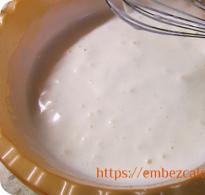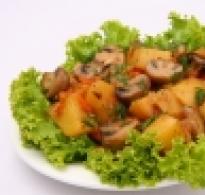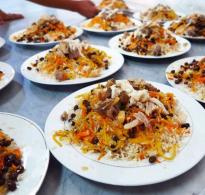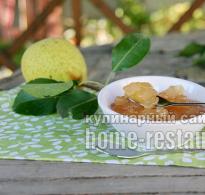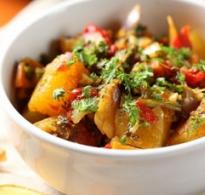What are the benefits of Big Red Robe tea? Da hong pao - properties of tea big red robe
Da Hong Pao - Translated from Chinese as Big Red Robe. It grows in the Wuyi Shan Mountains in northwestern Fujian Province. It belongs to the oolong family and is famous not only throughout China, but also beyond its borders.
Legends about the origin of the name Big Red Robe
According to a manuscript found in Tian Xing Si Monastery, Da Hong Pao tea got its name and widespread popularity after an event that happened in 1385. Student Ding Xian suffered a heatstroke while going to take exams, and one of the monks of the monastery cured him with tea. As a result, the guy successfully passed the exam and took an honorary position. Then he returned to the monk and gave him his red robe (a symbol of honor and respect), but he, following the traditions of Buddhism, refused the gift. Then Ding Xiang, as a sign of his gratitude, put a red robe on the tea bush that saved his life. Since then, this type of tea has been called the big red robe.
There is another legend according to which, with the help healing properties The emperor's mother was cured by tea. As a sign of gratitude, the emperor ordered the production of huge red robes to be placed on four tea bushes, the leaves of which were used in the treatment of his mother.
Technology and production
Da Hong Pao is produced using a unique technology:
- The raw materials are laid out in a thin layer in the fresh air or in a ventilated area so that the sheet loses some of the moisture and becomes suitable for further processing.
- The leaves are gently crushed until the juice is released, this allows you to speed up the fermentation. Then they are allowed to rest and absorb oxygen.
- The prepared raw materials are sent into a hot cauldron for several minutes. Roasting stops the oxidation process and the tea retains all the most beneficial substances.
- Final drying. The tea is heated in wicker baskets over coals for 24 hours.
The Chinese say that after the final stage of production, tea should be allowed to rest for at least a month, so it will become richer and tastier.
Thanks to this technology, Da Hong Pao is perfectly stored for several years without losing its qualities.
Buying da hongpao is not easy even in China itself. The demand is so great that there are not enough mother bushes of the Great Red Robe and other raw materials are used for production. Due to this, you get a slightly different tea and you will be very surprised when you try the collection from the mother bushes.
Tasting
- Color: Da Hong Pao infusion is light brown in color with a golden hue.
- Aroma: Deep with a hint of dried fruit.
- Taste: tart, from a distance reminiscent of roasted sunflower seeds.
- Aftertaste: not long but deep.
Da Hong Pao: effect and beneficial properties
Da Hong Pao is still one of the best natural energy drinks and an excellent medicinal drink. Used in traditional Chinese medicine and at monasteries.
Besides this:
- Excellent warmth in cold and damp weather
- Tones and increases blood pressure.
- Promotes concentration.
- Relieves fatigue.
- Helps digestion.
How to brew Da Hong Pao

For this oolong, dishes made of clay or porcelain are best suited. Yes hong pao perfectly structures and purifies water. But it is still not advisable to use water with chlorine impurities and a high metal content.
To properly brew da hong pao we need:
- Heat the water to a temperature of 90 degrees.
- Warm the dishes thoroughly.
- Use 10-15 grams of tea per 200 ml container.
- Rinse the tea with boiling water and you can start brewing.
- Pour in the water, wait 5-10 seconds and the drink is ready.
- The third brew should be held for 2-3 seconds longer, and each subsequent brew should be held for an additional 10-15 seconds.
You can also brew da hong pao using Lu Yu's method, or rather, boil it. To do this:
- Take a heat-resistant glass kettle and fill it with water.
- For a volume of 1.5 liters. we use 25-30 grams of da hong pao.
- Soak the tea for 1-2 minutes in cold water.
- Bring a kettle of water to almost a boil.
- Make a funnel in boiling water and add tea.
- After 20-30 seconds, remove the kettle from the heat and let the tea brew for 3-5 minutes.
- Pour the resulting broth into a thermos and start drinking tea.
How to brew Da Hong Pao: video
This video shows the process of brewing da hong pao according to a classic Chinese recipe.
Da Hong Pao Production: Video
Video guide to the Ui Mountains, from the Da Hong Pao plantations themselves to the production factory.
We have described the most popular methods of brewing dahongpao, but there are others besides them, which we will publish in the future on our blog.
Have a pleasant and healthy tea party!
There is constant debate among tea connoisseurs about which varieties are healthier - black or green. Each of these two types of drink has its own huge advantages and minor disadvantages. But oolongs, which are between green and black teas in terms of fermentation, combine the advantages of both types. They do not cause insomnia, although they act as a tonic. And the best of Chinese oolongs The tea is considered to be “Big Red Robe”, or “Da Hong Pao”. In this article we will talk in detail about this variety: about its benefits and possible disadvantages, about proper brewing drink, about the effect it produces on the body. What do reviews say about “The Red Robe”?
"Da Hong Pao" in the oolong family
So-called blue teas originated in the Chinese province of Fujian about 400 years ago. When processing, the leaves are not fermented entirely, but only at the edges. This preserves the green richness in the inner layers. The full name of this type of tea is “Ming Bei Wulong”, which means “Black Dragon from northern Fujian”. A drink made from oolong (or, as it is also called, oolong) retains its freshness and aroma. A rich taste makes it similar to black teas. Over four centuries, the oolong family has been replenished with new varieties. Now they are grown not only in Fujian, but also in Guangdong and Taiwan. Based on the degree of processing, highly, medium and weakly fermented oolongs are distinguished. But the raw materials from those bushes that grow in the mountains are always more valuable. This is the so-called cliff tea. "Red Robe" belongs to this type. In addition, it is grown only in the homeland of oolongs, in Fujian province, or more precisely, on the slopes of the Wuyi Mountains. Raw materials for “Da Hong Pao” are collected only from the “mother bushes” that gave birth to this variety. And the harvest is harvested only once a year - in the first two weeks of May. Only the top four leaves are selected for tea. All this makes the “Red Robe” the most valuable, and therefore expensive variety oolong

Origin of the name
"Da Hong Pao" means "Big Red Robe" in Chinese. There are many legends about the origin of the name in Fujian Province. According to one of them, this type of tea restored the health of the mother of one of the emperors of the Ming dynasty. As a sign of gratitude, the monarch ordered to decorate the bushes from which the leaves for the drink were collected with red robes. Scarlet color in China is a symbol of celebration, honor and respect.
The second legend about the name of the tea variety “Red Robe” (“Da Hong Pao”) was preserved in the archives of the Tian Xin Si Monastery. A certain student named Ding Xian went to the court in 1385 to take the imperial exam there. Since it was summer, the traveler suffered heatstroke. One of the Tian Xin Si monks brewed tea and gave it to the victim to drink. He immediately felt better and continued his journey. Ding Xian successfully passed the exam, received the desired government position and set off on his way back. Driving past the monastery, he decided to thank the monk who saved him and gave him a red robe embroidered with dragons. But the hermit, who had taken vows of abstinence from luxury, refused such a rich offering. Then the official threw a red robe over the tea bush.

Production "Da Hong Pao"
We have already mentioned that the variety has control of origin. Its "terroir" is limited to the Wuyi Mountains in northwestern Fujian Province. The variety is harvested only in the first half of May. Moreover, only the cluster of the first four leaves is removed from the branches of the bush. The harvest is laid out in a thin layer in the shade or in a well-ventilated area. The leaves spend several hours there. When they lose some of the liquid and become soft, a little flaccid, they are carefully kneaded by hand. This is done so that the juice is released and air gets inside the tissues of the tea leaf, which speeds up the oxidation process.
When the desired degree of fermentation is achieved, the raw material is fried for several minutes in a dry kettle. Then the leaves are curled lengthwise and dried again. But this is not Red Robe tea yet. This produces only a semi-finished product. Throughout the summer, deft female hands tear off cuttings and longitudinal veins from dried leaves. And then the raw materials go through a process called Hong Bei. The leaves are placed in wicker baskets and placed over coals for several days. The heat is regulated by a layer of ash. And only after that the tea is packaged.

How to distinguish a fake?
All of the above only substantiates the fact that “Da Hong Pao” is a very expensive variety. The price of Red Robe tea in Russia averages 750 rubles per hundred grams. That is why cheaper oolongs are so often sold under the name “Da Hong Pao”. How to distinguish real elite tea from fakes? The curled leaf of the “Red Robe” should resemble the curved body of a dragon. The color of this oolong is not gray-turquoise, like its other brothers, but greenish-brown and even reddish-brown. You should also focus on the smell of the raw materials. "Big Red Robe" exudes a high, sweet aroma. It is similar to the smell of old aged wine or dried fruits, with exotic spicy notes. It should be noted that “Da Hong Pao” is used in the Chinese tea ceremony Gongfu Cha.

Brewing method
Once upon a time, American President Nixon visited China. During the visit, the distinguished guest was presented with a box of Red Robe tea as a gift. Arriving home, Nixon made tea in the American style - simply pouring boiling water into a cup with dry leaves. And later the president complained to the senators that everywhere he was given something worthwhile and only in China - some kind of hay. The diplomatic scandal was hushed up. Why did we remember this incident? Because if you brew the Big Red Robe the way Nixon did, you'll end up with a really gross drink that tastes like rye bread. How to prepare this oolong correctly? You need to heat the porcelain teapot with boiling water. Pour out the water. Add the tea leaves. Pour boiling water, close the teapot and immediately get rid of the water. It will remove not only dust, but also unwanted taste impurities. And then pour in the tea leaves hot water, but not boiling water. Let it brew for a minute. After this, you can pour the drink into bowls.

The uniqueness of "Da Hong Pao"
Don't rush to throw away the tea leaves! Big Red Robe tea can withstand about ten consecutive pours of hot water. And this should not be done because of savings. Each time you brew, the taste of the tea will change, so that the audience will have the impression that they are enjoying different varieties. The first drink has a dark, almost brown color. Subsequently it brightens to amber shade. The same metamorphoses occur with the bouquet. Rye notes give way to the smell of baked chestnuts, and then light fruity and floral nuances appear. The tart taste of the first drink is almost immediately replaced by endless, velvety sweetness. Export versions of the Big Red Coat are often flavored. But the Chinese themselves believe that such additives only spoil the excellent long-lasting aftertaste of Da Hong Pao.

Tea "Red Robe": properties
The Chinese themselves call this variety “magic nectar.” Let us remember that it appeared, according to legend, as a medicinal drink. And this is not surprising. This oolong contains B vitamins, as well as C, K and E. “Red Robe” is also rich in useful microelements and chemical compounds: tannins, caffeine, polyphenol, manganese, magnesium, iodine, phosphorus, calcium, iron, selenium and zinc. Fluoride in tea strengthens tooth enamel and gums. The drink lowers cholesterol, strengthens the immune system, and helps with colds, bronchitis and sore throats. It is good for heart patients because it breaks up atherosclerotic plaques.
Da Hong Pao also has contraindications. Firstly, you should not use it at night if you do not want to suffer from insomnia. Pregnant and breastfeeding women should keep their consumption of oolong to a minimum. Hypertensive patients and ulcer sufferers should also drink Red Robe with caution. For acute respiratory infections and elevated temperature You should also give preference to black varieties of tea. You cannot take Da Hong Pao with medicine.

“Red Robe”: the effect of tea for weight loss
This variety of oolong can be an excellent ally in the fight against extra pounds. It normalizes metabolism, accelerates metabolism, and has a mild diuretic effect. In addition, it suppresses appetite. Women on a strict diet are often nervous. The effect of Red Robe tea (Da Hong Pao) is similar to a state of mild euphoria. It calms the nerves and helps cope with stress. For schoolchildren and students, a cup of this oolong will be an ideal start to the day, as the drink clears the mind, strengthens memory, and charges with vivacity and energy. It has an excellent effect on the condition of the skin, hair and nails.
How to brew:
90C, 300 ml.
Filtered
Time
30 sec. - 1 min.
Quantity
2-3 teaspoons, 8 gr.
When to drink
Any time of the day
Tea leaves
Up to 7 times

Chinese name: 大红袍.
Region of origin: China, Wuyi Shan, Fujian Province.
Plantation height: 800 m above sea level.
Other names: Big Red Robe, Scarlet Robe, Da Hongpao, Da Hong Tea
Appearance: Curly, striped leaves with a brown-green edge around the leaf edge. |
|
| Color tea infusion: The drink is dark yellow-orange in color. | |
| Aroma: Warm aroma combined with notes of sweetness, milk and fresh flowers. | |
| Palate: Warm notes of roasted cocoa combined with a delicious floral and creamy sweet aroma. The charcoal roasting method gives this tea greater depth of flavor. |
Chinese tea Da Hong Pao (Big Red Robe) is the king of the five famous teas from the Wu Wuyi Mountains in China, truly legendary tea. It dates back to the beginning of the 18th century (Dao Guang era). During the Qing Dynasty, Da Hong Pao was rightly called the "King of Tea". In 1998, the Chinese government put it up for sale for the first time, and the tea was sold to a group of auctioneers for almost $900,000. Da Hong Pao, which means "Big Red Robe", is a rare oolong from the Wuyi region in Fujian Province of China. Oolongs from the Wu Wuyi Mountains grow among mountain boulders, making it very difficult to grow. This tea is highly prized for its “mountain taste”, and only real tea from the Wu Wuyi mountains, rather than tea from the nearby plateaus, will have this unique taste.

Tea sommelier's commentary
If you are looking for new taste sensations, then the Chinese tea Big Red Robe, which comes from the Ming Dynasty, will truly delight you royal taste. Fully brewed with a deep, nutty and floral finish combined with amazing health benefits! Da Hong Pao is considered one of the high mountain teas. It is produced in Fujian, China, grown in soil rich in manganese, magnesium and potassium, and is highly respected by tea connoisseurs around the world for its unique taste qualities and health benefits.
History of Da Hong Pao Tea
According to legend, the mother of a Ming dynasty emperor was cured of an illness by drinking tea, and the emperor gave large red robes to clothe the four tea bushes that provided the leaves for the medicine. It is believed that three of these bushes survived and still produce leaves for tea. Less than 1 kilogram of tea was harvested from these plants each year, some of which was requisitioned by the Chinese government. Since 2005, part of the stock of this tea has been sold at auction with a starting price of 4,000 yuan per 100 grams, but the price often reaches tens of thousands to millions of dollars per kilogram.

Da Hong Pao tea was over a hundred years old and became a real treasure. Six huge tea bushes are protected at the national level. The spring harvest permit was revoked in 2006. Currently in use asexual reproduction, thanks to which hundreds of hectares of land are covered with tea bushes that have identical qualities to the original plants.

Tea collection and production
The adventure of this Chinese oolong tea begins in late spring with the first harvest and subsequent smaller harvests in the fall. Only buds with three or four mature leaves will be selected to begin the magical process. The leaves are first dried indoors or sometimes outdoors to speed up the drying process.

After this, they are laid out on bamboo tables and turned over by hand. Next, they are gently shaken, pressed by hand and fired to stop the oxidation process. This tea is semi-fermented, reaching only 40% oxidation. Finally, the leaves are rolled and heated several times to finally create the Big Red Robe, consisting of long, twisted green-chestnut shoots. This drink is rarely found on the market and is mostly reserved for honored guests in China. Less than a kilogram of tea is harvested each year from these original tea bushes, so when purchasing tea, don't be surprised by the price as it is quite expensive!

When you drink Da Hong Pao (Big Red Robe), you're not just enjoying an amazing, unique drink. You will also be able to enjoy the benefits of tea. See how oolong tea can help revitalize your body and mind.
Properties and benefits of red robe tea
Tea from Mount Wu has a high amount of polyphenols, which are a natural antioxidant. Many signs of aging include dark spots, rough skin, wrinkles - people report a reduction in these symptoms when regular use tea. Typically, a cup of authentic tea contains between 20 and 40 mg. polyphenols. This is more than most vegetables, which are considered food sources. high content antioxidants. There are several varieties of oolong tea, but most of them share the same health and weight loss benefits that help in preventing or reversing the signs of aging.

| ① | Fat Burning: Teas from the Wu Mountains are known for their weight loss properties, and this tea is no exception. This aromatic tea is the ideal drink to help you boost your metabolism throughout the day and allow you to burn fat, build muscle and stay fit. Start drinking 4-5 cups a day, especially before work. If you want to see positive and lasting results, say goodbye to the couch, commit to moving, and make it a habit to shop for healthy food! Day after day, your body will feel the difference and you will never stop smiling. |
| ② | Coffee alternative: Being an oolong tea, Big Red Robe contains approximately 12-55 mg. caffeine, so what could it be best way How to start your day with a cup of this refreshing Chinese tea? This will give you a boost of energy and keep you energized throughout the day without causing stress or anxiety. Start making healthy choices today! |
| ③ | Digestion Aid: Whenever you're at a friend's party and can't resist large quantity delicious food, there is always a way to feel better! Tea will help you dissolve excess acidity and avoid heartburn. Food will taste much better and you will feel fresher and lighter. |
| ④ | Strong Heart: Are you taking care of your heart? Da Hong Pao will reduce blood pressure and levels of bad cholesterol and blood sugar, helping you fight serious diseases, namely diabetes. The benefits of tea are enormous and will have positive influence for your life. |
How to brew this Chinese oolong
As you can see, the use of this tea on a daily basis can provide you and your loved ones with many important health benefits. 
To fully enjoy the taste and benefits of tea, you must prepare it correctly. We will tell you how to do this:
If possible, brew the tea in a Yixing clay teapot to allow the tea to release its fragrant aroma. These special teapots are not only works of art, but over time they begin to absorb the taste and aroma of the tea brewed in them, making each subsequent brew even more exquisite.
| ① | Preheat the kettle and cups by rinsing them with hot water. After that, pour out this water. Then heat the water to 90ºC (194ºF). Always use spring water clean water so that impurities in the water do not affect the taste of this wonderful tea. |
| ② | Fill the teapot one-third full with tea leaves and add water. Cover the kettle with a lid and let steep for 30 seconds to 1 minute for the first and second brews, increasing the time for each subsequent brew. This tea can withstand 7 brewing stages: 30 sec., 30 sec., 40 sec., 60 sec., 80 sec., 120 sec. |
| ③ | Give yourself a moment to enjoy the beauty and depth of color of this amber drink and feel its floral aroma. Serve tea in a simple, minimalistic atmosphere to highlight the benefits of this wonderful drink. |
| ④ | It is believed that this tea is good in combination with fried fish, tofu and desserts, but if you want something lighter, try making sandwiches. |
Forget everything you've heard about Da Hong Pao.
What's going on with Da Hong Pao?! Chinese tea Da Hong Pao is known to everyone who is advanced in the tea topic. Da Hong Pao is sold in every tea shop, but not many tea lovers know that real Da Hong Pao is difficult to find in Russia!
Da Hong Pao is a popular brand, for this variety they can give you: bush tea Shui Xian and Zhou Gui (related varieties of Da Hong Pao), large-leaf types of holly, truncated clover and willow - these leaves are as dark as those of Da Hong Paoto give them aroma and taste, flavor enhancers and flavoring agents will be added with just such teaThe shelves of tea stores and online stores are missing.
The issue of quality and authenticity of Da Hong Pao is not entirely clear. We went to China, to the Wuyishan farmers from the original place where Da Hong Pao grew.
![]()
![]()
A real Da Hong Pao leaf always has a red border; a wet leaf will always show this. The aroma of freshness and chocolate and baked buns.
![]()
![]()
How to check Da Hong Pao for quality?
In the Wuyi Mountains, in addition to Da Hong Pao, more than 800 varieties of tea are prepared, they all have much in common, often rare varieties tea is available only in some individual peasant tea farm; of course, even the Chinese tea growers, who absorbed the tea culture with their mother’s milk, cannot distinguish between all these varieties. There are three main varieties of bush from which Wuyi teas are made: Wuyi Zhou Gui, Shui Xian, Da Hong Pao. Wui Zhou Gui grows on sunny slopes and absorbs Yang energy, its leaves are long, fleshy, dense, the taste is extremely straight, strong, not distinguished by the game of taste, the action is long-lasting, vigorous. Shui Xian is softer in taste with a long play of aftertastes, grows in shady gardens, acquiring Yin energy, the leaf is long, delicate and thin, with a light twist. Da Hong Pao plays with shades of fruit, chocolate flavors, leaf 1.5-2 cm. Half the size of Zhou Gui and Shui Xian, delicate thin leaf.
Before choosing a real Da Hong Pao, please note:
1. Teeth on the edge of the brewed leaf, along the edges there is a red edge.
2. The aroma is fruity-chocolate, nutty with notes of cocoa, the leaf is medium and softer than those of Shui Xian and Zhou Gui.
3. Integrity of the leaf, check for dust in the tea leaf - if these signs are present, then it’s not very good good tea; the tea should not smell something sour, and the aroma should not contain notes of heavily roasted tea leaves.
4. High-quality Da Hong Pao leaves are not cut; there should be no sticks or foreign leaves in the tea.
5. Check the tea for the number of brews; high-quality tea can withstand 15-20 brews.
6. Check the sleeping tea leaf, it should not be oily, the leaves should be uniform and pleasant to the touch.
Da Hong Pao effect
Da Hong Pao brings us into harmony and balance, while maintaining calm concentration and performance. Da Hong Pao - the tea that took bright aroma from green tea, strength and tonic effect from black tea. Emperors of various Chinese dynasties revered this tea, believing that it manifested best qualities person, his potential and creativity.
Da Hong Pao is suitable for those people who love strong teas, do not increase blood pressure and are calming nervous system, while giving good mood and physical activity.
We owe Da Hong Pao tea to Taoist monks
![]()
In ancient times, monks prepared tea in the Wuyi Mountains and researched medicinal herbs for spiritual and physical health. It is believed that Da Hong Pao neutralizes vices. The monks were experimenters: they planted tea bushes on different soils and slopes, collected tea in different weather conditions and observed their conditions. As a result, tea growing on stone soil formed by the cliff itself, which, growing in the wild, will survive in any conditions and later became known as Da Hong Pao for its strength and unusual energy.
The monks created treatises on Da Hong Pao, describing it as a tea that shows in a person perseverance, restraint, patience, calmness, a detached view of situations, a flexible mind, while Da Hong Pao relieves drowsiness and strongly tones.
Tea also helped improve physical health and was used for medicinal purposes when necessary.
![]()
Methods for preparing Da Hong Pao tea were invented in the Wuyi Mountains, and then they spread throughout China. Only a few abbots of the temple knew how to prepare tea. The monks believed that only a person of high moral character could appreciate the quality of tea, so ordinary monks and students were not allowed to prepare and taste it. Until now, in the Wuyi Mountains in the Tian Xin Si Monastery, the mother tree of the famous Da Hong Pao tea grows, the tea leaves from which are processed according to recipes of the 11th century.
The rarest Da Hong Pao tea is one of the famous Chinese rock oolongs with a centuries-old history. It has a memorable taste with a very persistent aftertaste. It has a unique relaxation effect while maintaining mental clarity.
Da Hong Pao tea – a diamond among oolongs
The recipe for true Da Hong Pao tea is over 600 years old. It is grown in the north-west of Fujian province, on the lands of the Tian Xin Si Monastery in the Wuyi Mountains. The name is translated into Russian as “big red robe”. At the same time, it is almost impossible to buy original tea of this variety - it grows on 6 tea bushes, from which 400 grams are collected. leaves per year and solemnly transferred to the state repository. Last time The tea harvest from those same bushes went on sale in 2006; its cost at auction was half a million dollars.
Da Hong Pao tea is a highly fermented oolong tea that is produced using complex technology. Under his name, descendants of the original mother bushes, which are grown in the same natural conditions, are now sold. For this purpose, a special government decree was adopted, according to which all Wuyishan cliff oolongs can be called Da Hong Pao. It is difficult even for experienced tea masters to distinguish these related oolongs from each other by taste, aroma and effect.
Origin of the name
The history of the name of tea is shrouded in legends. One of them says that with an infusion of Da Hong Pao leaves, the monks once saved a student who suddenly lost consciousness on the way to an exam. I put a mug of tea young man on his feet, he successfully passed the exam and earned a position, which came with a red robe as a uniform. With gratitude, the former student returned to the monastery and offered his robe to the bushes from which that healing infusion was made.
Other sources say that after his healing, the student heard about the insidious illness of the emperor’s wife, which the best doctors could not heal. He managed to give her some Da Hong Pao tea leaves, which helped the woman recover. For this, the emperor gave the trees the best red fabrics to protect them from frost.
Manufacturing technology
The raw materials for proper Da Hong Pao oolong are carefully selected according to several parameters. Preference is given to tea bushes from the slopes of the Wuyi Mountains; the age of the bush is also taken into account - the older it is, the more it is valued on the market. Leaves are collected 4 times a year, of which autumn leaves are considered the most saturated.
The first collection of leaves occurs in May. They are cut along with the stems and laid out on the street until the moisture evaporates. Then they are loaded into rotating containers to release juice and enhance fermentation. After a few days, the fermentation is stopped, the leaves are fried in cauldrons, rolled and dried. At the next stage, the leaves are torn from the stems and sorted. At the final stage, the raw materials are heated over coals or in a special oven. As a result, the leaves darken and become greenish-brown and brown. Depending on the time of the final stage, the tea turns out to be strong, medium or lightly roasted. At the end, the leaves are packaged and sent to stores.
It is not difficult to distinguish good tea from old and low-quality tea. Fresh leaves bright and dense. Try rubbing one leaf in your hands - if lumps form, it means the raw material has not been dried correctly. Old leaves crumble into fine powder.

Color, smell and taste
Proper Da Hong Pao tea should be uniform, rich dark color with green and chestnut reflections. Its aroma is deep and sweet, with notes of fruit, vanilla and freshness. An infusion made from fresh raw materials has a persistent aroma; if it disappears during subsequent brewing, a dye has been added to it.
The taste is pleasant and very individual, its perception depends on the temperament and mood of the person drinking this magical infusion. Notes of caramel or fruit, vanilla or toffee - they are united by a soft taste that envelops and leaves behind a long sweet aftertaste. Each new brewing of one serving of tea tastes slightly different from the previous one, giving a new flavor to this drink.
Useful properties
The popularity of Da Hong Pao came from its effect on the body. Known for "Da Hong" pao effect“- a mug of this tea warms and relaxes, pushes all problems into the background, pacifies and calms. Thoughts flow smoothly and internal pressures recede, while the brain works clearly and clearly. This state is called tea intoxication - relaxation without fog.
Oolong Da Hong Pao has properties to gently stimulate the immune system, slow down aging, ridding the body of free radicals. It strengthens teeth and helps lower cholesterol levels. However, the effects of tea also depend on how you brew Da Hong Pao.
How to brew correctly
Let's figure out how to brew Da Hong Pao? Follow these steps:
- Take water and bring to a boil.
- Rinse the kettle with boiling water.
- Pour 7 grams into the kettle. Da hong pao and fill with water that has cooled to 90-95 degrees.
- After 5 seconds, pour the infusion into cups to warm them up, then drain.
- Fill the tea leaves with water again and leave for about a minute.
- Re-brew one serving 6-7 times, increasing the infusion time by 15 seconds.
Experiment with infusion time and amount of raw materials to obtain new flavors!


